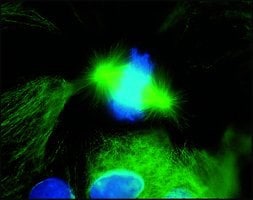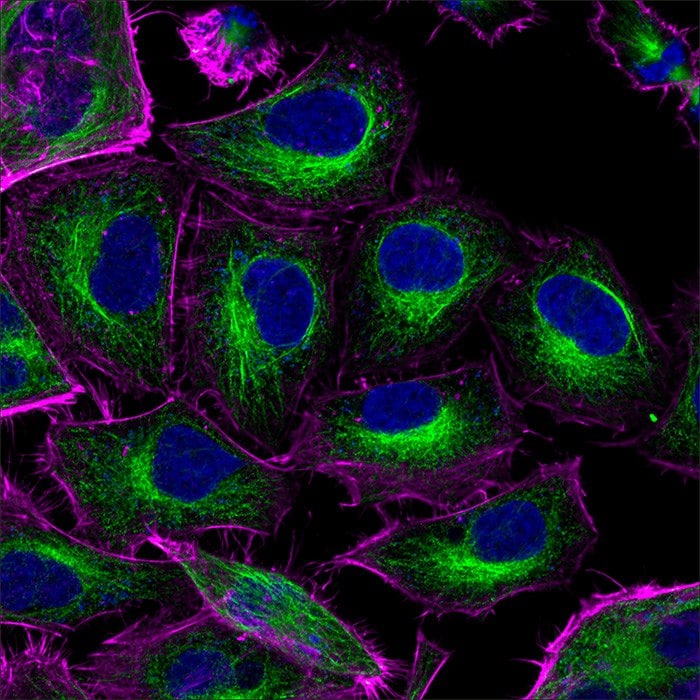Secondary Antibodies

Figure 1.Immunofluorescence. Equine exuberant granulation (proud flesh) tissue stained using Anti-von Wille.
Secondary antibodies are polyclonal or monoclonal antibodies that bind to primary antibodies or antibody fragments, such as the Fc or Fab regions. They are typically labeled with probes that make them useful for detection, purification, or sorting applications.
We offer secondary antibodies from a variety of host species. Our polyclonal secondary antibodies are produced from the serum of host animals such as mice, rabbits, goats, and sheep. Whereas, our monoclonal secondary antibodies are produced from mouse hybridoma clones.
Need Help Finding The Correct Antibody for Your Application?
Use our Antibody Explorer search tool to view and compare antibodies by clonality, application, species, reactivity, conjugate, host species, and form.
Products
Not finding the right product?
Try our Product Selector Tool.

Figure 2.Fluorescent micrographs of mitotic newt lung cells. Microtubules stained with Monoclonal Anti-^.

Figure 3.Immunocytochemistry. Frozen section of Rat optic nerve stained with Mouse Anti-neurofilament H and CF568 Goat Anti-Mouse (neuronal processes, red), Rabbit Anti-GFAP and CF488A Goat Anti-Rabbit, highly cross-adsorbed (glial cells, green). Nuclei are stained with RedDot2 (cyan).
Conjugated Antibodies and Probes
We offer a large portfolio of conjugated antibodies. A conjugated antibody is a monoclonal or polyclonal antibody linked to a label and used for detection in a diverse range of assay techniques. The specific utility of a secondary antibody depends upon its conjugated probe(s). Probes are molecules that support various detection technologies. The most common detection systems for conjugated secondary antibodies are colorimetric or fluorescent.
Colorimetric assays are typically based on the use of alkaline phosphatase (ALP) or horseradish peroxidase (HRP) or its derivatives. The biotin avidin (streptavidin) conjugate binding system is often used to amplify the colorimetric signal for ALP or HRP. The most common fluorescent assays utilize fluorescein isothiocyanate (FITC), Rhodamine or its derivative, tetramethylrhodamine isothiocyanate (TRITC), cyanine (Cy3), or phycoerythrin (R-PE).
We offer conjugated antibodies linked to a variety of colorimetric and fluorescent labels for use in detection, purification, sorting, and microscopy applications. Conjugated antibodies are produced in a variety of host animals making them compatible with a broad range of immunochemical reagents. For those users whose research requires labeling their own reagents, we offer antibody labeling kits for the conjugation of various labels (biotin, FITC, CF™ labels) to monoclonal and polyclonal antibodies.
Protein A, G, and L
Protein A is derived from Staphylococcus aureus. Protein G is derived from a Streptococcus species. Both have binding sites for the Fc portion of mammalian IgG. The affinity of these proteins for IgG varies with the animal species. Protein G has a higher affinity for rat, goat, sheep, and bovine IgG, as well as for mouse IgG1 and human IgG3. Protein A has a higher affinity for cat and guinea pig IgG (Table 1). In addition to IgG Fc binding sites, native Protein G contains binding sites for albumin, the Fab region of Igs, and membrane binding regions, which can lead to nonspecific staining. These problems have been addressed by creating recombinant forms of the protein. Recombinant Protein G has been engineered to eliminate the albumin binding region, and recombinant Protein G′ is a truncated protein that lacks the albumin, Fab, and membrane binding sites while retaining the Fc binding site, making it more specific for IgG than the native form.
Protein L, from Peptostreptococcus magnus, has an affinity for kappa light chains (Table 2) from various species. It will detect monoclonal or polyclonal IgG, IgA, and IgM as well as Fab, F(ab′)2, and recombinant single-chain Fv (scFv) fragments that contain kappa light chains. It will also bind chicken IgG. Note: Species such as bovine, goat, sheep, and horse whose Igs contain almost exclusively lambda chains will not bind well, if at all, to Protein L.
Detection Reagents
Protein A and G are used as a general, non-species-specific reagent for binding primary antibodies or surface IgG in mammalian tissues. Protein G is recommended for most species, including mouse and rat. Protein A is recommended for cat and guinea pig. Neither is recommended for detection of IgA or IgM, for detection of Fab fragments, or detection of avian IgG. When bound to a resin like agarose, Protein A and Protein G may be used to affinity purify immunoglobulins from serum or ascites fluid.
Protein L is used as a general reagent for binding primary mammalian or avian antibodies or surface Igs of all classes. Especially useful for detection of Fab, F(ab′)2 fragments, and recombinant scFv fragments, for detection of Igs bound to Fc receptors, or for detection of monoclonal antibodies in the presence of bovine Igs. Use is limited to detection of Igs bearing kappa light chains.
Resins
Protein A and Protein G have binding sites for the Fc portion of mammalian IgG. The capacity of these proteins for IgG varies with the species. In general, IgGs have a higher affinity for Protein G than for Protein A, and Protein G can bind IgG from a wider variety of species. The affinity of various IgG subclasses, especially from mouse and human, for Protein A varies more than for Protein G. Protein A can, therefore, be used to prepare isotypically pure IgG from some species. Protein L is suitable for isolating mouse monoclonal antibodies from cell culture supernatants without contamination by bovine IgG.

Figure 4.CF™ Dye. HeLa cells stained with Mouse-Anti-tubulin and CF488A Goat Anti-Mouse secondary antibody (microtubules, green). Actin filaments are stained with CF640R phalloidin (purple). Nuclei are counterstained with DAPI (blue).
CF™ Dye Labeled Antibodies
CF™ dyes are a series of highly water-soluble fluorescent dyes spanning the visible and near-infrared (near-IR) spectrum for labeling antibodies. Developed by scientists using breakthrough chemistries, the brightness, photostability, and color selection of CF™ dyes rival the quality of other commercial dyes as a result of rational dye design.
We offer highly validated CF™ dye labeled secondary antibodies in a variety of species-specific options.
Related Resources
- Article: How to Choose a Secondary Antibody
Review the key factors that should figure in your decision to choose a secondary antibody. Learn about species, subclass, isotype, label, and more.
- Article: Tips for Immunofluorescence Protocols
Immunofluorescence uses antibody-conjugated fluorescent molecules for protein localization, modification confirmation, and protein complex visualization.
- Article: Using Conjugated and Secondary Antibodies
Using conjugated antibodies and secondary antibodies in the lab.
To continue reading please sign in or create an account.
Don't Have An Account?